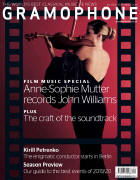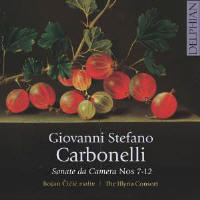Texte paru dans: / Appeared in: |
|
|
Outil de traduction (Très approximatif) |
|
|
Reviewer:
Charlotte Gardner When Bojan Čičič and his Illyria Consort gave us the first six of Carbonelli’s set of 12 violin sonatas (8/17), it was by no means a foregone conclusion that the second half of the set would follow, so this sequel is welcome indeed. For those in need of a quick refresher, Giovanni Stefano Carbonelli (1694-1773) was one of the many Italian violinists who arrived on British shores from the late 17th century onwards. Also, indeed, one who stayed, anglicising his name after his naturalisation in 1735 to John Stephen Carbonell and enjoying a successful musical career on London’s various stages before switching career to become an equally successful wine merchant. His 12 violin sonatas are his only surviving music; Nos 8, 9 and 11 are appearing here as debut recordings, so this second instalment means we now have the entire set on disc for the first time. However, it’s worth noting that this sequel doesn’t simply serve up more of the same. For starters, in addition to the violin-plus-continuo sonatas, there’s a larger-forces surprise (two violins, viola, cello, double bass, harpsichord and theorbo) in the form of Vivaldi’s Il Carbonelli Concerto in B flat, whose nickname – penned on the manuscript by Vivaldi’s German pupil Pisendel – presumably signifies that Carbonelli played it for an admiring composer in Venice around that time. Here it appears crisp and buoyant, with the engineering giving a bright, ear-grabbing immediacy to the sound, without trying to smooth off too many of the period instruments’ rough edges. Try Čičič’s first solo entry at 0'30" for size. When we get to the sonatas, it’s clear that Carbonelli himself has not stood still. For instance, the second movements are no longer fugal. Also there are interesting stylistic originalities such as No 8’s ditching of the slow-fast model in favour of a central pair of allegros followed by a slow extended reprise of the sonata’s attractive opening ‘Pastorale’. Throughout the six Čičič’ (still on his c1680 Ruggieri) is as much a joy as last time for his superlative virtuoso technique and energetic poetry. Meanwhile, the continuo is also still constantly ringing the colouristic changes, David Miller switching between theorbo, archlute and Baroque guitar, and Steven Devine between harpsichord and organ, with the whole expertly underpinned by Susanne Heinrich’s seven-string bass viol. With such wall-to-wall elegant exuberance and excellence on show across both discs, you shouldn’t hesitate in adding them as a pair to your collection.
Gramophone talsks to Bojan Čičič
The baroque violinist considers the little-known music
of Giovanni Carbonelli
How did you discover this set of sonatas?
What sets Carbonelli’s music apart from his contemporaries? It’s interesting to look at what happened after Carbonelli’s career as a violinist in London: he became a very successful wine merchant. This might have been because he couldn’t compete with the in lux of younger, predominantly Italian violinists to London, with their more galant style of composing. On the other hand, Sonata XI offers us Carbonelli at his most virtuosic and modern, showing that he was neither completely stylistically calci ied, nor immune to modern developments in violin technique. Why haven’t other violinists championed this music? Why modern baroque violinists have stayed away from Carbonelli is beyond me. Perhaps we live in an era when it’s much harder for musicians to take risks, because we have to be extremely careful to choose the right project in which to invest our own time and effort, and money. But if the story of Carbonelli’s discovery tells us anything, it is that as long as you have passion for what you do, others will follow. |
|




